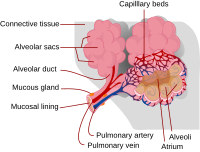
Photo from wikipedia
Compromised regeneration resulting from the deactivation of Wnt/β-catenin signaling contributes to the progression of chronic obstructive pulmonary disease (COPD) with limited therapeutic options. Extracellular cytokine-induced Wnt-based signaling provides an alternative… Click to show full abstract
Compromised regeneration resulting from the deactivation of Wnt/β-catenin signaling contributes to the progression of chronic obstructive pulmonary disease (COPD) with limited therapeutic options. Extracellular cytokine-induced Wnt-based signaling provides an alternative option for COPD treatment. However, the hydrophobic nature of Wnt proteins limits their purification and use. This study devises a strategy to deliver the membrane-bound wingless-type MMTV integration site family, member 3A (Wnt3a) over a long distance by anchoring it to the surface of extracellular vesicles (EVs). The newly engineered Wnt3aWG EVs are generated by co-expressing Wnt3a with two genes encoding the membrane protein, WLS, and an engineered glypican, GPC6ΔGPI -C1C2. The bioactivity of Wnt3aWG EVs is validated using a TOPFlash assay and a mesoderm differentiation model of human pluripotent stem cells. Wnt3aWG EVs activate Wnt signaling and promote cell growth following human alveolar epithelial cell injury. In an elastase-induced emphysema model, impaired pulmonary function and enlarged airspace are greatly restored by the intravenous delivery of Wnt3aWG EVs. Single-cell RNA sequencing-based analyses further highlight that Wnt3aWG EV-activated regenerative programs are responsible for its beneficial effects. These findings suggest that EV-based Wnt3a delivery represents a novel therapeutic strategy for lung repair and regeneration after injury.
Journal Title: Advanced science
Year Published: 2023
Link to full text (if available)
Share on Social Media: Sign Up to like & get
recommendations!